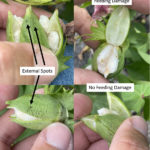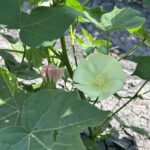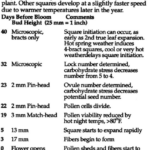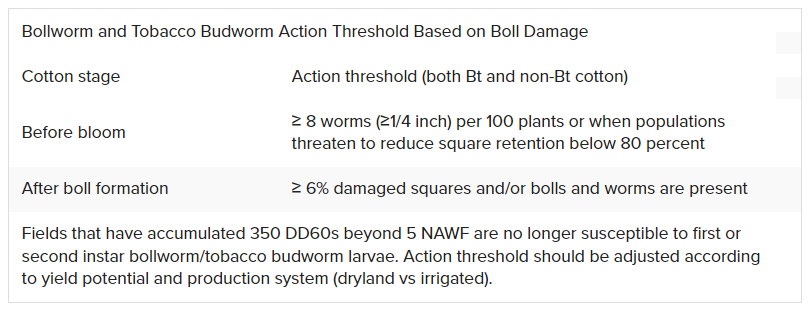Many of the cotton fields in South Texas are in bloom. Once cotton is blooming, we need to change our scouting methods. Plant water use is increasing rapidly and the insects that cause yield loss are changing.
Now is the time to start counting Nodes Above White Flower (NAWF). This will help you know how the crop is progressing and when insects stop being an economic pest. Count NAWF by finding the first position white flower and counting the number of nodes (branches) above the branch with the white flower. The last node to count is the highest node with an unfurled main stem leaf (at least 1-inch wide).
Unstressed cotton fields should have 8-9 NAWF in the first week of bloom. Expect the NAWF to decrease as the boll load increases or if moisture stress occurs. In a healthy fruiting crop, the NAWF will go down by 1-1.5 nodes per week and be at 5 NAWF in the 4th week of bloom.
After the first week of bloom, the fruit you have on the plants is pretty much what will be harvestable. This is due to the time required for a square to bloom and mature to an open boll. A pinhead square should be a bloom in 23 days and a bloom will mature to an open boll in 50-60 days. You can find a wealth of good information here: https://www.cotton.org/tech/physiology/
In fields with poor square set, during the first week of bloom, it may be beneficial to continue to scout for the cotton fleahopper and treat fields that exceed a threshold of 10-15 per 100 plants. After the first week of bloom, I don’t think fleahoppers are an economic pest.
 When a field is in bloom, begin to look for stink bugs and evidence of their feeding. This stink bugs are usually difficult to find so economic thresholds have been developed based on evidence of internal boll feeding. Remove 10 to 20 bolls, one inch in diameter, from each of four parts of the field, avoiding field edges. Break open the bolls by hand or cut them with a sharp knife. Look for internal warts on the boll walls and stained lint on the cotton locks. External spots do not mean the boll is damaged, but check bolls with spots first because bolls without spots are not usually fed on internally.
When a field is in bloom, begin to look for stink bugs and evidence of their feeding. This stink bugs are usually difficult to find so economic thresholds have been developed based on evidence of internal boll feeding. Remove 10 to 20 bolls, one inch in diameter, from each of four parts of the field, avoiding field edges. Break open the bolls by hand or cut them with a sharp knife. Look for internal warts on the boll walls and stained lint on the cotton locks. External spots do not mean the boll is damaged, but check bolls with spots first because bolls without spots are not usually fed on internally.
Once the cotton has reached 450 DD60 (degree days 60) beyond cutout (five nodes above the white flower), sampling and treating for stink bugs may no longer be necessary since bolls produced after this point will not become fully mature or contribute significantly to the crop yield.
While most of the cotton is Bt cotton, I suggest you also check for bollworms. This is especially important in cotton without the VIP gene. Search the entire plant for bollworm eggs, larvae and injury. A proper sample includes squares, white blooms, pink blooms, bloom tags, and bolls. Reduce the scouting intervals to 3 to 4 days during periods of increasing bollworm egg- laying, especially during peak bloom. The presence of eggs alone should not trigger treatment since hatching larvae must first feed on the cotton plant to receive a toxic dose.



